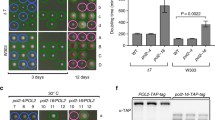Abstract
In many eukaryotes it is thought that cell proliferation is regulated at a point in G1 close to the initiation of DNA synthesis1. Hartwell2,3 and his colleagues have shown such a point in G1 phase in the budding yeast, Saccharomyces cerevisiae, defined by the cdc 28 mutation. He has termed this point ‘start’ and showed that for cells to proceed beyond start, initiate DNA synthesis and produce a bud, various conditions must be met. Two of these conditions are the presence of adequate nutrients in the medium and the attainment of a critical size. We identify here some of the genes controlling start by isolating mutants which are altered with respect to the conditions in which start occurs. Two types of mutant have been isolated. One results in bud initiation when the parent cell is only half the size at which bud initiation occurs in wild-type cells. Such mutants define a single gene, whi-1, and they are apparently analogous to the size mutants isolated by Nurse and his colleagues4–6 in Schizosaccharomyces pombe. A second type of mutation affects a second gene, whi-2, which is involved in the mechanism whereby cells arrest in G1 in stationary phase. whi-2− cells growing exponentially initiate buds at the same size as wild-type cells. In stationary phase, however, whi-2− cells, unlike wild-type cells, are predominantly budded and are smaller than wild-type cells.
Similar content being viewed by others
References
Prescott, D. M. Adv. Genet. 18, 100–178 (1976).
Hartwell, L. H. Bact. Rev. 38, 164–198 (1974).
Johnston, G. S., Pringle, J. R. & Hartwell, L. H. Expl Cell Res. 105, 79–98 (1977).
Nurse, P. Nature 256, 547–551 (1975).
Nurse, P. & Thuriaux, P. Expl Cell Res. 107, 365–375 (1977).
Thuriaux, P., Nurse, P. & Carter, B. L. A. Molec. gen. Genet. 161, 215–220 (1978).
Carter, B. L. A. & Sudbery, P. E. Genetics (in the press).
Guerineau, M., Slonimski, P. P. & Avner, P. R. Biochem. biophys. Res. Commun. 61, 462–469 (1974).
Fantes, P., Grant, W. D., Pritchard, R. H., Sudbery, P. E. & Wheels, A. E. J. theor. Biol. 50, 213–244 (1975).
Harris, M. Expl Cell Res. 66, 329–336 (1971).
Lorincz, A. & Carter, B. L. A. J. gen. Microbiol. 113, 287–296 (1979).
Adams, J. Expl Cell Res. 106, 267–275 (1977).
Weiss, R. L., Kukora, J. R. & Adams, J. Proc. natn. Acad. Sci. U.S.A. 72, 794–798 (1975).
Layne, E. Meth. Enzym. 3, 447–462 (1957).
Mitchison, J. M. Expl Cell Res. 13, 244–262 (1957).
Goldstein, D. in Analytical and Quantitative Methods of Microscopy (eds Meek, G. A. & Elder, H. Y.) 137–158 (Cambridge University Press, 1977).
Author information
Authors and Affiliations
Rights and permissions
About this article
Cite this article
Sudbery, P., Goodey, A. & Carter, B. Genes which control cell proliferation in the yeast Saccharomyces cerevisiae. Nature 288, 401–404 (1980). https://doi.org/10.1038/288401a0
Received:
Accepted:
Issue Date:
DOI: https://doi.org/10.1038/288401a0
- Springer Nature Limited
This article is cited by
-
Scaling gene expression for cell size control and senescence in Saccharomyces cerevisiae
Current Genetics (2021)
-
Whi2: a new player in amino acid sensing
Current Genetics (2019)
-
Transcriptional profiling reveals molecular basis and novel genetic targets for improved resistance to multiple fermentation inhibitors in Saccharomyces cerevisiae
Biotechnology for Biofuels (2016)
-
A pharmaco‐epistasis strategy reveals a new cell size controlling pathway in yeast
Molecular Systems Biology (2013)
-
The critical size is set at a single-cell level by growth rate to attain homeostasis and adaptation
Nature Communications (2012)





